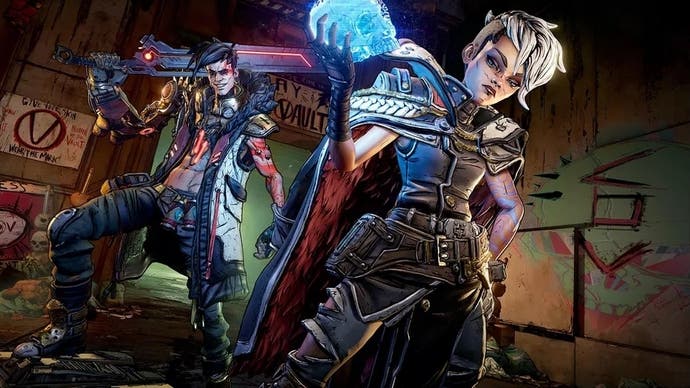Borderlands 3 PC: six tweaks that boost frame-rate with no real hit to quality
Best settings suggestions for the new Gearbox game.
While Borderlands as a franchise is an acknowledged best seller on consoles, the series plays best on PC thanks in no small part to the keyboard/mouse interface and higher framer-rates. Historically, it's also been relatively easy to run on PC too - but there is the sense that Borderlands 3 isn't quite so optimal. Regardless, Gearbox has shipped the game with a raft of graphical settings to play with, along with support for both DX11 and DX12 APIs. Can you run at 1080p at 60 frames per second on a mid-range PC? With some judicious settings tweaks it is possible - and you won't be losing much in the way of visual fidelity either.
Going into the game, the first big decision to make from a settings perspective is whether to run under DX11 or the experimental DX12 option. After running some benchmarks, we found plus and minus points for each API. Generally speaking, if you are not CPU-constrained, DX11 can provide faster results than DX12 - so in our mid-range test rig using a Core i5 8400 with GTX 1060, graphics are our primary bottleneck, meaning that DX11 is the best choice. However, if you're opting to run the game at high frame-rates, DX12 is the better option when you're CPU-constrained instead.
For our tests then, DX11 it is. We found that running with the older API delivered performance at least on par with DX12, but often ran up to seven per cent faster in like-for-like scenarios. We should expect Gearbox to improve performance over time with DX12 as the feature moves out of beta, but in the here and now we would expect the older API to be the better fit for most PC gamers.
The next most important preset is - perhaps predictably - resolution. For a GPU like the GTX 1060, full HD is the best fit for its capabilities, but straight out of the box at the fully maxed 'badass' settings, a 40fps turn-out isn't likely to impress. Borderlands 3 does feature an internal resolution slider, but for some reason, it's not exactly granular - adjusting the slider downwards from 100 per cent takes you to 75 per cent, or 1440x810. We'd hope to see the slider improved in a future patch, but thankfully .ini tweaks can shift this variable to where you would want it. 83 per cent would correlate to 900p, while 90 per cent would deliver 1728x972.
However, using the internal resolution scaler or dropping resolution across the board with the display option should only be used as a last resort - the fact is that you don't need ultra or indeed badass settings and there are some key performance wins by adjusting select presets to medium, with very little loss in noticeable image quality.
Pick of the settings tweaks is to lower volumetric lighting quality. Borderlands 3 uses the same kind of 'froxel' grid approach to its volumetrics as many other recent titles, and you can add a lot of performance with only a minimal, mostly unnoticeable hit to image quality. The medium preset adds an extra 34 per cent to frame-rate, making it the by far the most impactful setting beyond raw rendering resolution.
Beyond that, I'd recommend lowering the quality of screen-space reflections from ultra to medium, for an additional 10 per cent of performance. This keeps SSR as part of the visual mix, but in my tests, the extra precision offered by the higher quality renditions of the effect doesn't really register owing to the way Gearbox authors its artwork and how materials are handled generally in Borderlands 3.
By extension, the material quality preset itself can move from ultra down to medium too - the performance boost isn't substantial at just four per cent, but it's enough to warrant the change. Less significant still is the screen-space ambient occlusion option, where ultra to high delivers another couple of points without impacting quality to any degree that actually matters. Surprisingly, shadow quality tweaks also produce very little in the way of a performance boost but again, the medium setting offers the best balance between visual fidelity and performance.
| Ultra/On | High | Medium | Low | Off | |
|---|---|---|---|---|---|
| Volumetrics | 100% | 109% | 134% | - | 139% |
| SSR | 100% | 100% | 110% | - | 112% |
| SSAO | 100% | 102% | 102% | 102% | - |
| Material Quality | 100% | 102% | 104% | 104% | - |
| Shadows | 100% | 100% | 103% | 103% | - |
| Motion Blur | 100% | - | - | - | 103-107% |
Beyond that, there is one final cut to make that can have a noticeable boost to frame-rates - disabling motion blur. As a fan of the effect, this one should hurt. However, the fact is that the implementation in Borderlands 3 is subtle enough that removing it isn't that much of a big deal and in the process, you can gain between four to seven per cent more performance.
Beyond that, further settings tweaks are mostly down to taste and won't deliver much in the way of appreciable extra performance. My optimal settings line-up would be to start by choosing between DX11 and DX12, then lowering everything to high before dropping volumetrics, screen-space reflections, shadows and material quality down to medium. The chances are that the game should run a lot faster but look much the same. Experiment with the motion blur toggle if you need a bit more speed but fundamentally, this is as far as settings tweaks go before you need to take more drastic action with the resolution slider or its .ini equivalent.
Ultimately - and understandably - the move to Unreal Engine 4 presents much more of a challenge in optimising performance on the new Borderlands, but even with the more limited scope we had in tweaking for a locked 60fps, the GTX 1060 could still rise to the challenge. Meanwhile, the CPU side of the equation didn't present too many problems on our i5 8400/GTX 1060 rig - but if you do find yourself CPU-limited to any meaningful degree, that's where the beta DX12 support could prove useful. And it'll certainly be interesting to see how the DX12 implementation evolves over time - at the very least we'd be hoping for performance parity with DX11.










